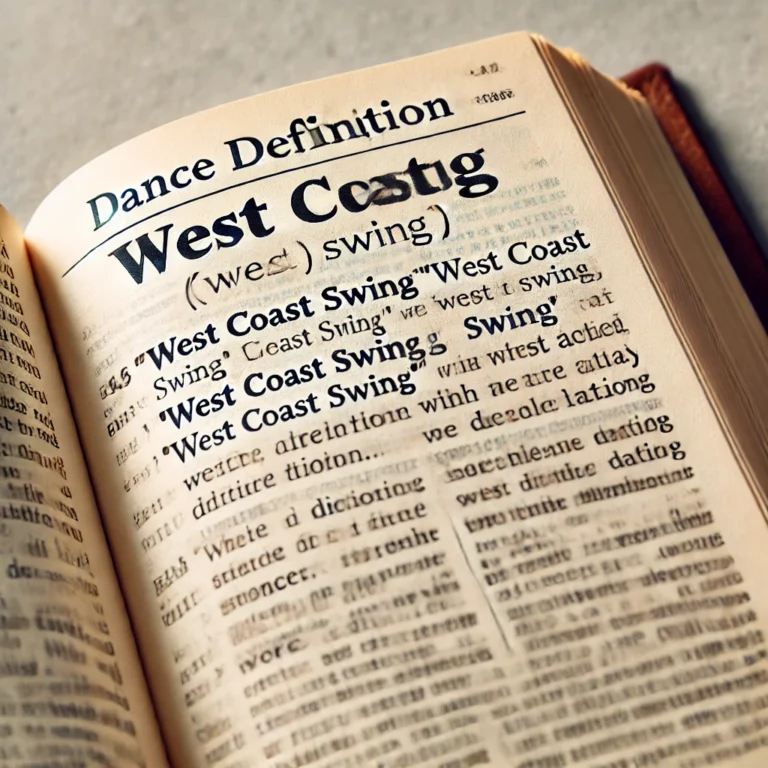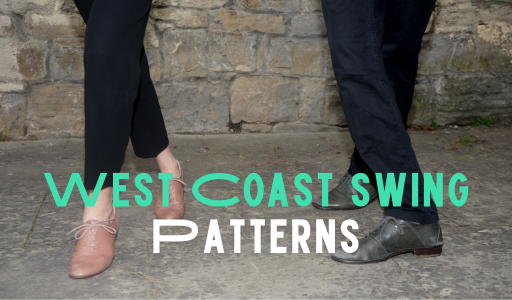West Coast Swing is a unique dance with crucial definitions for dancers. Terms like “slot,” “anchor,” and “whip” describe the dance’s structure and movements.
Knowing these West Coast Swing definitions helps dancers communicate effectively and stay in sync with their partners. It also ensures that everyone understands the dance’s framework, making learning new moves and styles easier.
Understanding these terms enhances the dance experience, allowing for greater creativity and connection on the dance floor.

Table of contents
Basics
Anchor Step
In West Coast Swing, the anchor step is a foundational move that completes each six- or eight-count pattern and resets the partners for the next sequence. It typically occurs on counts 5 and 6 (or 7 and 8 in eight-count patterns). To execute an anchor step:
- Placement: Dancers settle into a slightly back-weighted position.
- Feet: The leader and follower usually place their feet in a small, triple-step pattern (e.g., left-right-left for leaders, right-left-right for followers).
- Connection: Maintain a flexible connection with your partner, ensuring you’re ready to transition smoothly into the next move.
This step helps maintain the dance’s characteristic elasticity and ensures smooth, connected transitions between patterns.
Connection:
Refers to the physical and sometimes visual link between dance partners that allows for effective communication and synchronized movements. It involves maintaining a gentle yet responsive pressure through the hands, arms, and sometimes the body, ensuring both partners can feel and respond to each other’s cues.
Count
Refers to each beat in the music dancers use to time their movements. West Coast Swing typically involves six-count or eight-count patterns, meaning that dancers complete a sequence of steps within six or eight beats.
Keeping track of counts helps the dancer stay in sync with the music and their partner, ensuring smooth transitions and rhythmic accuracy throughout the dance. Counting also aids in precisely executing steps and patterns, contributing to a cohesive and enjoyable dance experience.
Follower
The follower is the dance partner who responds to the leader’s signals and movements. The follower interprets and reacts to cues, maintaining a flexible yet firm connection to move in sync with the leader. This role involves staying attentive and responsive, using body positioning and frame to execute steps and patterns.
Lead
The leader is the dance partner who initiates and directs the movements in the dance. The leader uses clear, intentional signals through their frame, body positioning, and sometimes visual cues to communicate the next steps or patterns to the follower.
This role requires maintaining a confident and responsive connection, anticipating the follower’s movements, and ensuring smooth transitions. The leader is responsible for guiding the dance, creating opportunities for the follower to express their styling, and keeping the dance in sync with the music.
Pattern
A “pattern” in dance refers to a specific sequence of steps and movements completed within a set number of counts, typically six or eight. Patterns provide structure and predictability, allowing partners to move in harmony. Common examples include the Sugar Push, Left Side Pass, Right Side Pass, Tuck Turn, and Whip.
Walk Walk
Various patterns use a basic step sequence. It consists of two steps taken forward or backward. Each step corresponds to a single beat of music, creating a smooth, natural progression.
Triple Step
Three steps are taken within two beats of music, often executed as a quick-quick-slow pattern.
Each step involves a weight transfer, creating a rhythmic and flowing movement. This step is commonly used to add syncopation and texture to the dance, helping to maintain the rhythm and connection between partners.
Compression
Compression in dance refers to the controlled application of force between partners, creating a feeling of resistance or “springiness.” This is achieved by slightly bending the knees and engaging the core muscles while maintaining a firm yet flexible frame. Compression is used to communicate timing and direction changes, enhancing the connection and responsiveness between partners.
Extension
Extension in dance involves a controlled outward stretch between partners, creating a sense of length and tension. This is achieved by moving away from each other while maintaining a connected frame, often through the arms and hands. It helps communicate direction changes, timing, and movements.
Slot
The slot is an imaginary narrow lane on the dance floor in which the follower moves back and forth while the leader mostly stays in place or moves slightly to facilitate the follower’s movements.
Turn
A turn in dance involves a dancer rotating their body around a fixed point, typically on one or both feet. Turns can be executed in various directions and styles, such as spins, pivots, or twirls.
Syncopation
Syncopation involves emphasizing beats or parts of beats that are typically unaccented, creating a rhythmic variation that adds complexity and interest to the dance. This technique disrupts the regular flow of the rhythm, making it feel more dynamic and unexpected. Syncopation can be achieved through various footwork patterns, timing adjustments, and body movements.
Frame
In West Coast Swing, an individual dancer’s frame is crucial for maintaining connection and executing movements smoothly. The frame consists of the dancer’s posture and body alignment. Key elements include:
- Posture: Stand tall with a slight forward lean from the ankles, not the waist.
- Core Engagement: Keep the core muscles engaged for stability.
- Arm Position: Arms should be relaxed but firm, allowing for responsive connections with the partner.
- Flexibility: Maintain a balance between firmness and flexibility to accommodate the dance’s fluid movements.
This structure allows for partner communication and synchronization, enhancing the dance experience.
Break
A break refers to a brief pause or change in the movement pattern that marks the end of one sequence and the beginning of another. This momentary stop can emphasize a musical beat, transition to a new pattern, or allow dancers to reset their positions.
Patterns

Push Break (or Sugar Push)
The leader guides the follower forward and back, creating a push-pull dynamic.
It typically spans six counts and includes a compression followed by an extension. The move starts with the leader inviting the follower to step forward, creating a moment of compression, and then both partners move back to their original positions, creating an extension.
Tuck Turn
Like Push Break, the leader guides the follower into a turn following compression. The sequence typically involves:
- Setup: The leader initiates a tuck by compressing the connection, bringing the follower closer and raising the arm.
- Turn: The leader then directs the follower into a turn, often using a hand or arm to guide the movement.
- Completion: The follower completes the turn, returns to the starting position, or continues into the next move.
Side Pass (left and right)
The follower passes by the leader, usually on the leader’s right side, while both partners maintain their connection. The sequence typically involves:
- Initiation: The leader signals the side pass, guiding the follower to move past them.
- Passing: The follower steps forward, moving to the leader’s side, often crossing in front or behind.
- Completion: Both partners re-establish their positions and are ready for the next move.
Inside Turn
The follower is led to turn inward, towards the leader’s hand or arm. The sequence typically involves:
- Initiation: The leader raises their hand, signaling the turn.
- Turning: The follower turns towards the raised hand, rotating under the leader’s arm.
- Completion: The follower completes the turn, returning to a facing position or continuing into the next move.
Outside Turn
The follower is led to turn away from the leader, creating an outward rotation. The sequence typically involves:
- Initiation: The leader raises their hand, signaling the turn.
- Turning: The follower turns away from the leader’s raised hand, rotating outward under the leader’s arm.
- Completion: The follower completes the turn, returning to face the leader or transitioning into the next move.
Whip
A whip involves the follower being led into a pivot turn, typically spanning eight counts. The sequence includes:
- Initiation: The leader pulls the follower towards them, creating a compression.
- Pivot: The follower pivots, turning 180 degrees while maintaining the connection.
- Redirection: The leader redirects the follower back down the slot, creating an elastic motion.
- Completion: The follower finishes the turn, returns to the starting position, or transitions into the next move.
Styling and Musicality

Hit
Is a precise, sharp movement or accent that aligns with a specific beat or musical cue. This technique emphasizes a particular moment in the music, adding dramatic effect and highlighting the rhythm.
Hits can be executed through various body parts, such as a sudden stop, a sharp arm movement, or a quick foot placement.
Sweep
A smooth, continuous movement where the foot glides along the floor in an arc. This action can be performed with one or both feet and is often used to transition between steps or to add stylistic flair.
Sweeps require balance and control, as the dancer must maintain a stable upper body while executing the fluid leg movement.
Dip
A dip involves the leader lowering the follower backward or to the side, creating a dramatic and graceful pose. This move requires trust and control, as the leader supports the follower’s weight while maintaining a strong, stable frame. The follower maintains tension in their body to ensure a smooth and safe descent.
Rock Step
A rock step involves a quick weight shift from one foot to the other, usually performed in two counts. The dancer steps back to the side with one foot, shifting their weight onto it, and then shifts it back to the original foot.
This move creates a rocking motion often used to initiate or transition between other dance steps.
Back Lead
Back lead refers to the follower initiating or anticipating a move instead of waiting for the leader’s signal. This can disrupt the intended flow of the dance and communication between partners. It typically occurs when the follower tries to predict the leader’s actions or takes control of the movement.
Mirror Position
The mirror position is when dance partners face each other and perform the same movements as if looking into a mirror. Each dancer’s right side mirrors the other’s left and vice versa. This alignment helps practice synchronization and ensures both dancers know each other’s movements.
Lunge
A lunge in dance involves stepping forward or to the side with one leg while bending the knee and keeping the other leg extended behind. This creates a strong, dramatic pose, often used to highlight specific moments in the dance or transition between movements. Proper technique requires maintaining a straight back, engaged core, and balanced weight distribution.
Drop
A drop-in dance involves the leader supporting the follower as they lower their bodies toward the ground, creating a dramatic and visually striking position. This move requires trust and precise coordination between partners.
The leader ensures the follower’s safety by maintaining a strong frame and providing adequate support, while the follower maintains body tension to control the descent.
Body Isolation
Body isolation in dance refers to moving one part of the body independently from the rest.
This skill involves isolating specific muscles or body parts, such as the shoulders, hips, or head while keeping other areas still. Body isolations create sharp, defined movements and enhance the expressiveness of the dance.
Pulse
Pulse in dance refers to the consistent, rhythmic movement that aligns with the beat of the music. It involves a subtle, repetitive action, often a gentle bounce or contraction and release of the body, that helps maintain timing and flow.
Counterbalance
Counterbalance in dance involves partners using each other’s weight to create a stable and dynamic position. By leaning away from each other while maintaining a connected frame, they achieve a balanced state where both dancers’ weights are equally distributed.
